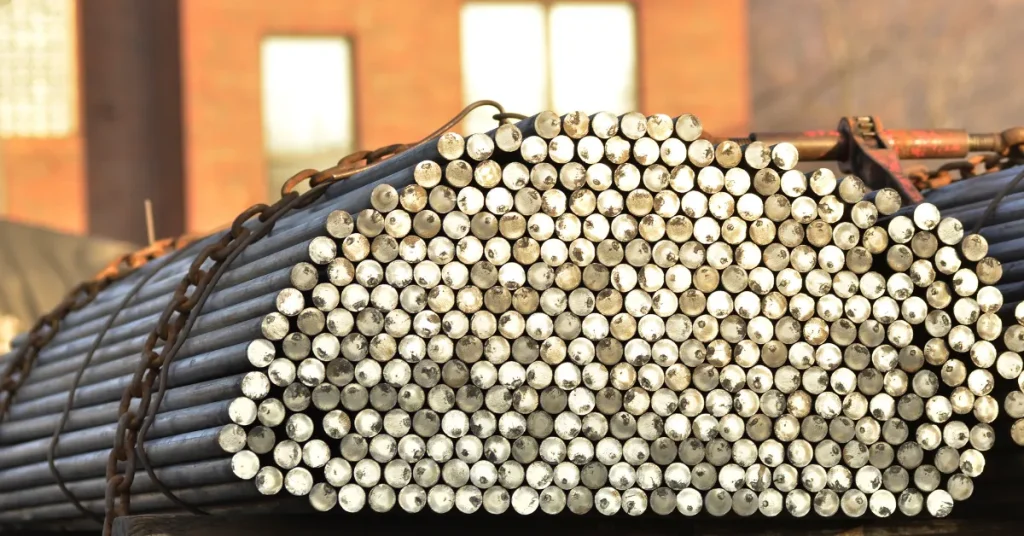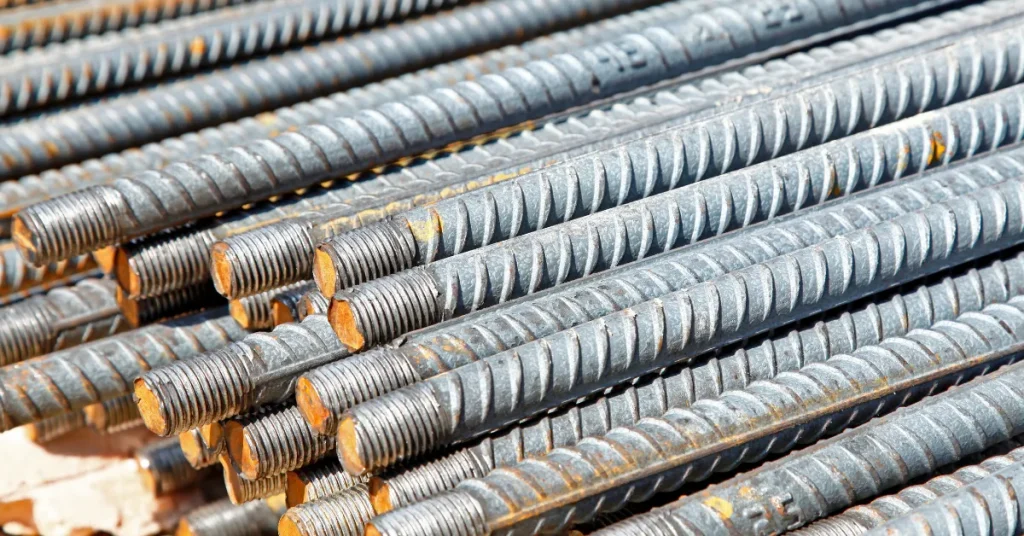4 rebar, also known as #4 rebar, measures 1/2 inch in diameter. This corresponds to 0.5 inches, or roughly 12.7 millimeters thickness.
Rebar, short for reinforcing bar, is central to construction projects, providing the tensile strength needed for concrete structures.
The sizing of rebar is critical for ensuring the integrity and safety of buildings, bridges, and highways. 4 rebar is a commonly used size, offering a balanced combination of flexibility and strength.
Contractors and builders often choose #4 rebar for its versatility in a wide range of applications, including residential slabs, driveway paving, and even garden landscaping features.
Understanding the dimensions and proper utilization of #4 rebar is essential for meeting building codes and achieving optimal structural stability.
Its 1/2 inch thickness is reliably consistent, adhering to industry standards and allowing for predictable reinforcement in a variety of concrete installations.

The Essentials Of Rebar
Understanding the backbone of construction starts with rebar. Rebar or reinforcing steel bar is key to building. It strengthens concrete structures, making them tough. Let’s unravel the basics of rebar, focusing on thickness and its grades.
Defining Rebar And Its Purpose
Rebar is a steel bar used in construction. It reinforces concrete. Concrete is strong against squashing but weak when pulled or bent. Rebar fixes this weak spot.
Builders use rebar to make foundations, walls, and roads. You’ll find it in small home projects and large buildings. Think of rebar as a skeleton for concrete. It gives shape and strength.
Grades And Categories Of Rebar
Rebar comes in different types and strengths. Grades are important; they show rebar’s yield strength. Yield strength is how much force rebar can take before it bends.
| Grade | Meaning | Yield Strength |
| Grade 40 | Common grade | 40,000 psi |
| Grade 60 | Higher strength | 60,000 psi |
| Grade 75 | Specialized projects | 75,000 psi |
Size is also key. The number in rebar names shows thickness. For example, “4 rebar” is 1/2 inch thick. It’s about as thick as a pencil. Builders choose rebar size based on the project’s need.
Measuring Up: The Thickness Of Rebar

In the world of construction, rebar is a key element that provides strength to concrete structures. Understanding the thickness of rebar is essential for architects, engineers, and builders.
Here, we delve into the specifics of 4 rebar, a common size used in various building projects.
Standard Rebar Sizes And Dimensions
Rebar comes in different sizes, each identified by a number. The number refers to the diameter in eighths of an inch. Size 4 rebar has a diameter of half an inch. Here’s a quick overview:
| Rebar Number | Diameter (inches) |
| 3 | 3/8″ |
| 4 | 1/2″ |
| 5 | 5/8″ |
Comparing 4 Rebar To Other Sizes
Size 4 rebar is commonly used because it’s versatile and economical. Let’s see how it stacks up against other sizes:
- Size 3 – Smaller and used for lighter loads.
- Size 5 – Thicker and used for heavier loads.
Choosing the right size depends on the project’s needs. Size 4 rebar is a popular choice for its balance between strength and flexibility.
Gauging Rebar: Understanding The Numbers
When tackling any construction project, understanding the specifics of materials is crucial. Gauging rebar, particularly, involves a number system that might seem cryptic at first.
However, grasping what the numbers indicate is essential to ensure stability and safety in any structure. Let’s decode these numbers to uncover the mystery of rebar thickness.
The Significance Of The ‘number’ System
Rebar, short for reinforcing bar, greatly impacts a building’s strength. The ‘number’ system used for gauging rebar refers to its thickness. Each number corresponds to a one-eighth inch increment in diameter.
Therefore, a 4 rebar has a diameter of 1/2 inch because 4 times one-eighth equals four-eighths or half an inch. This number system helps constructors quickly choose the correct rebar size.
Why Size Matters In Construction
The thickness of rebar is a key factor in a structure’s integrity. Thicker rebar increases a structure’s ability to withstand tension and pressure.
For example, 4 rebar serves well in residential projects for concrete slabs and foundation walls. It is vital to select the proper size to avoid future complications and ensure durability.
| Number Size | Diameter (in inches) | Typical Usage |
| 3 | 3/8″ | Patios, driveways |
| 4 | 1/2″ | Residential foundations |
| 5 | 5/8″ | Commercial buildings |
- Rebar number equals thickness in eighths of an inch
- Diameter influences structural strength
- Choose size based on project needs
Selecting the appropriate rebar involves understanding both the number system and the project requirements. A deep comprehension of these elements leads to successful and long-lasting construction endeavors.
Strength In Numbers: The Durability Of 4 Rebar

Imagine a skeleton inside concrete structures. Rebar, or reinforcing bar, acts like bones within. Size 4 rebar is a commonly used size. Its strength helps buildings last for years. Let’s dive into what makes 4 rebar so reliable and where it’s best used.
4 Rebar Tensile Strength
Rebar’s muscle is in its ability to stretch. This is called tensile strength. Larger numbers mean thicker rebars. Size 4 rebar has a thickness of 1/2 inch. It can handle a lot of force without breaking. Here’s a look at its strength by the numbers:
- Diameter: 1/2 inch (12.7 mm)
- Grade 40 Tensile Strength: 70,000 psi
- Grade 60 Tensile Strength: 90,000 psi
- Grade 75 Tensile Strength: 100,000 psi
Applications And Limitations Of 4 Rebar
Size 4 rebar is versatile. Buildings and roads use it much. Though strong, it has limits. Let’s see what it can do:
| Applications | Limitations |
| Residential structuresConcrete pavementsRetaining walls | Not for heavy-duty bridgesLimited by its 1/2 inch diameterRequires proper placement |
4 rebar shines in standard buildings but not in massive bridges. Planning and careful assembly make sure it performs its best.
Beyond Gauge: Quality And Performance Factors
Understanding the thickness of 4 rebar is just the starting point. A deeper dive into quality and performance reveals factors like coatings and standards seriously matter. These play a huge role in the lifespan and strength of rebar in construction projects.
Coatings And Corrosion Resistance
Rebar can get special coatings to fight rust. These coatings give rebar superpowers against water and chemicals that cause rust. Let’s look at what kinds of coatings are out there:
- Epoxy Coating: This is like a durable paint that covers the rebar. It forms a protective shell and is often green.
- Galvanized Coating: A layer of zinc is added. It sacrifices itself to save the steel from rusting.
- Stainless Steel: Rebar made with stainless steel fights rust incredibly well but can be costly.
Certifications And Compliance Standards
High-quality rebar not only measures up in thickness. It must pass tests and meet strict rules. Check for these signs of top-notch rebar:
| Certification | Description |
| ASTM International | Verifies that rebar meets international safety and quality standards. |
| ISO | Shows the manufacturer has consistent processes that make great rebar. |
| CRSI | Concrete Reinforcing Steel Institute certifies ethical, environmental, and work standards. |
Remember, always look for these stamps of approval when choosing rebar for your project. They are badges of honor, proving the metal’s worth and reliability.
FAQs About How Thick Is 4 Rebar
How Thick Is Size 4 Rebar?
Size 4 rebar has a diameter of 1/2 inch or approximately 12. 7 millimeters.
How Thick Is 5 Bar Rebar?
A 5 bar rebar, also known as #5 rebar, has a thickness of 5/8 inches or 15. 875 millimeters.
How Thick Is Number 3 Rebar?
Number 3 rebar has a diameter of 3/8 inches or approximately 9. 5 millimeters.
How Thick Is #8 Rebar?
#8 rebar has a diameter of 1 inch or 25. 4 millimeters.
Conclusion
Understanding the thickness of 4 rebar is essential for any construction project. With a standard diameter of 1/2 inch, this reinforcement bar offers solid structural support.
Remember, choosing the right rebar size ensures the longevity and safety of your structures.
For your building needs, always consider the strength and quality of rebar.
